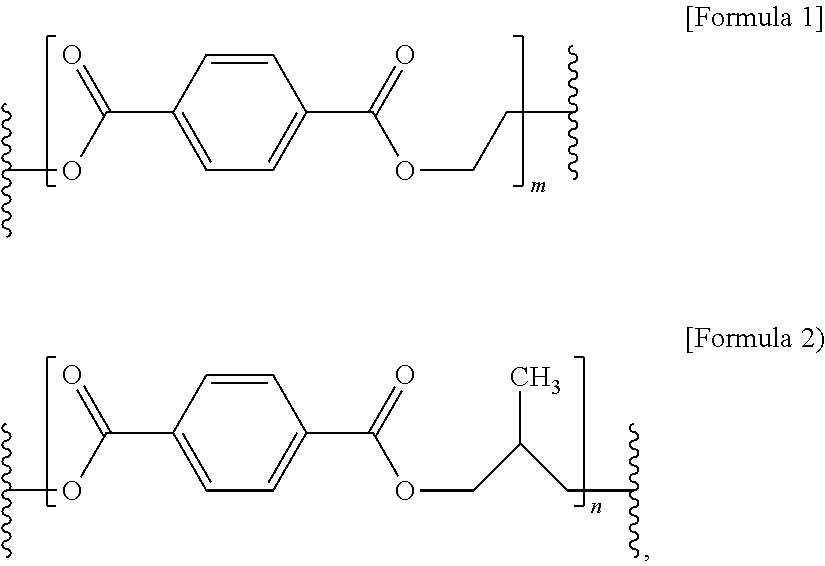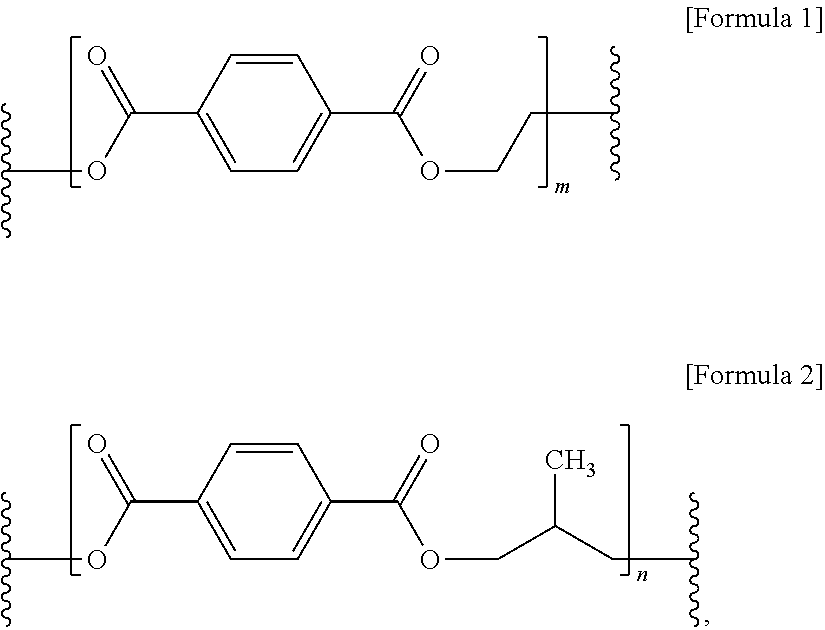Automobile interior and exterior materials comprising low melting polyester resin and methods for producing same
- Summary
- Abstract
- Description
- Claims
- Application Information
AI Technical Summary
Benefits of technology
Problems solved by technology
Method used
Image
Examples
preparation examples 1 to 24
[0095]Terephthalic acid (TPA) and isophthalic acid (IPA), as acidic ingredients; and 2-methyl-1,3-propanediol (MPD), ethylene glycol (EG), and diethylene glycol (DEG) as alcoholic ingredients were mixed in molar ratios, summarized in Table 1, in an esterification tank, and a general catalyst for esterification was added thereto, followed by performing esterification at 250±5° C. When an esterification rate reached about 96%, esterification was terminated, a catalyst for condensation polymerization was added thereto, followed by performing condensation polymerization such that a final temperature and vacuum pressure of the tank respectively reached 280±5° C. and 0.1 mmHg. The viscosity of a resultant resin was measured using a stirrer torque meter. When a desired viscosity was obtained, condensation polymerization was terminated. In this manner, the viscosity of a resin may be adjusted.
[0096]The tank was slowly depressurized and pressurized to discharge the ...
experimental example 1
[0098]The properties of a sample prepared according to each of Preparation Examples 1 to 24 were evaluated by the following items. Evaluation results are summarized in Table 2 below.
[0099](1) Cyclic Compound Content Measurement
[0100]10 mg of polyester resin was injected into a Pyrex tube having a diameter of 5 mm and a length of 20 cm until it was dissolved in trifluoroacetic acid (TFA) solvent to a height of about 5 cm. The 1H-NMR spectrum was measured using a nuclear magnetic resonance spectrometer (NMRS, Bruker). Based on the measured result, the content of a cyclic compound having a polymerization degree of 2 to 3 remaining in the low-melting-point resin was derived.
[0101](2) Measurement of Softening Temperature, Melting Point (Tm) and Glass Transition Temperature (Tg)
[0102]The melting point (Tm) and glass transition temperature (Tg) of the low-melting-point polyester resin were measured using a differential scanning calorimeter (DSC-7, Perkin Elmer). When a heat absorption peak...
examples 1 to 24
iber Layer
[0106]The first polyester resin fiber prepared according to each of Preparation Examples 1 to 24 was mixed with a second polyester resin fiber having a melting point of 255° C. or more, and thermoforming was performed while pressing at 130° C. As a result, a fiber layer was formed.
[0107]The second polyester resin fiber was prepared in the same manner as in Preparation Example 1 using a product (product name: SD, Semi-dull chip) manufactured by Huvis Inc.
[0108]A mixing ratio of the first polyester resin fiber to the second polyester resin fiber is based on parts by weight, and is summarized in Table 3 below.
TABLE 3First polyesterSecond polyesterExample No.resin fiber contentresin fiber content1~53.56.5 6~104611~155516~206421~2473
PUM
| Property | Measurement | Unit |
|---|---|---|
| Temperature | aaaaa | aaaaa |
| Temperature | aaaaa | aaaaa |
| Temperature | aaaaa | aaaaa |
Abstract
Description
Claims
Application Information
 Login to View More
Login to View More - Generate Ideas
- Intellectual Property
- Life Sciences
- Materials
- Tech Scout
- Unparalleled Data Quality
- Higher Quality Content
- 60% Fewer Hallucinations
Browse by: Latest US Patents, China's latest patents, Technical Efficacy Thesaurus, Application Domain, Technology Topic, Popular Technical Reports.
© 2025 PatSnap. All rights reserved.Legal|Privacy policy|Modern Slavery Act Transparency Statement|Sitemap|About US| Contact US: help@patsnap.com



